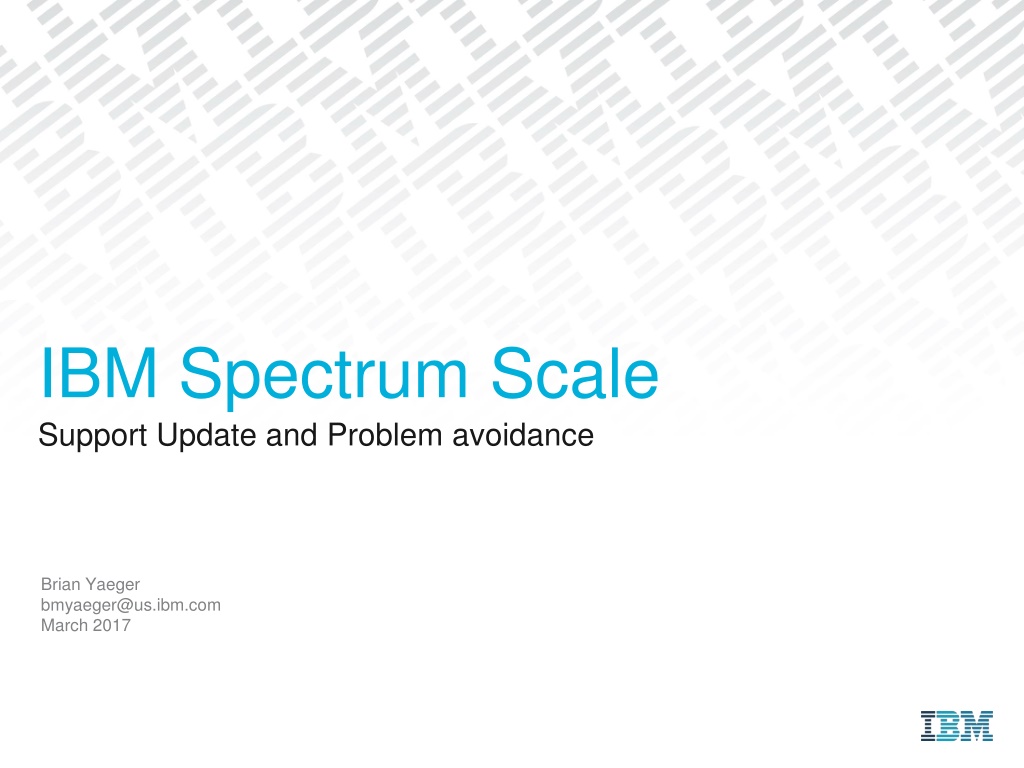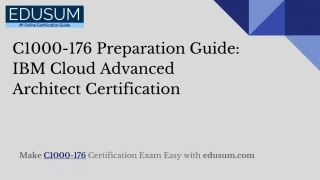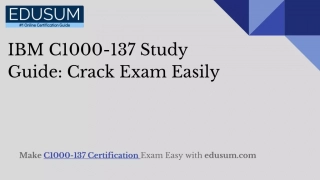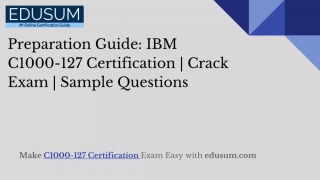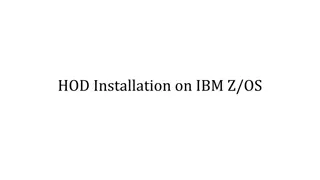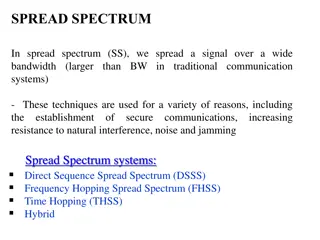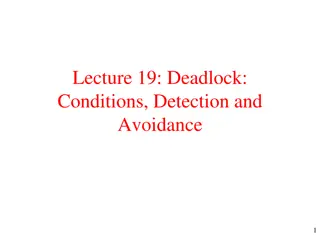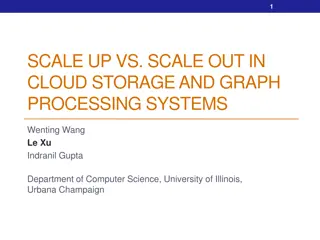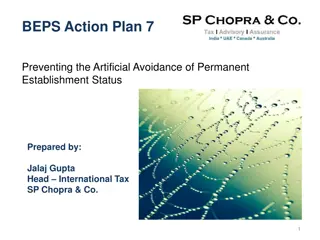IBM Spectrum Scale Software Support Update and Problem Avoidance Overview
Expanding support team in China, improving time zone coverage, enhancing problem classification, and implementing best practices in problem avoidance are key focuses of IBM Spectrum Scale Software Support. With a dedicated team in Beijing, response times for production outages have decreased, leading to better customer satisfaction. The initiative aligns support staff with customer time zones, ensuring round-the-clock coverage to address clients' needs effectively.
Download Presentation

Please find below an Image/Link to download the presentation.
The content on the website is provided AS IS for your information and personal use only. It may not be sold, licensed, or shared on other websites without obtaining consent from the author. Download presentation by click this link. If you encounter any issues during the download, it is possible that the publisher has removed the file from their server.
E N D
Presentation Transcript
IBM Spectrum Scale Support Update and Problem avoidance Brian Yaeger bmyaeger@us.ibm.com March 2017
Spectrum Scale Software Support Agenda Expanding our team in China Support Time Zone Coverage Support Managers Orthogonal problem classification top categories Service Best Practices in Problem Avoidance
Spectrum Scale Software Support Follow the sun support Aligning support staff to customer time zone Spectrum Scale Support is growing to better meet customer needs. Beginning late 2016 we substantially grew the support team in Beijing, China, with experienced Spectrum Scale staff. Improved response time on severity 1 production outages; reducing customer waiting time before L2 is engaged as well as time to resolution. Positive impact to timely client L2 communication for severity 2, 3, and 4 PMRs within our customer time zone. Full Beijing L2 team integration in follow the sun queue coverage scheduling starting in May. Additional improvements in queue coverage during customer time zone expected in 2017.
Spectrum Scale Software Support IBM Spectrum Scale Level 2 Support Global Time Zone Coverage Global team locations Poughkeepsie, NY USA Toronto, ON Canada Beijing, China
Spectrum Scale Software Support Support Delivery: Managers 1st Level: Bob Ragonese: ragonese@us.ibm.com; 1-845-433-7456 1st Level: Jun Hui Bu: bujunhui@cn.ibm.com; 86-10-8245-4113 2nd Level: Wenwei Liu: wliu@ca.ibm.com; 1-905-316-2623 Support Executive Andrew Giblon: agiblon@ca.ibm.com; 1-905-316-2582
Spectrum Scale Software Support Top 15 Spectrum Scale PMR Categories of 2016
IBM Storage & SDI Spectrum Scale Field Issues mmfsd daemon 17.10% Cluster Management 20.94% 7
IBM Storage & SDI Spectrum Scale Field Issues Not Spectrum Scale 13.36% File System 10.72% 8
IBM Storage & SDI Spectrum Scale Field Issues NSD (Network Shared Disk) 9.72% 9
Scenario 1: Spectrum Scale isn t starting after an upgrade. I ve upgraded my operating system and now GPFS won t start. Common causes: 1) Don't forget to compile the compatibility layer (kernel extension). 4.1.0.4 or higher: mmbuildgpl Prior versions: See /usr/lpp/mmfs/src/README 2) Blind across the board updates such as "yum -y -update", "aptget upgrade" etcetera can result in incompatible software combinations. In some cases the Spectrum Scale compatibility layer will not even compile, in other cases problems can manifest in unexpected ways. Review the FAQ, Check the relevant IBM Spectrum Scale Operating system support tables as well as the Linux kernel support table (if appropriate) to ensure if the kernel version has been tested by IBM. https://www.ibm.com/support/knowledgecenter/STXKQY/gpfsclustersfaq.html 10
Scenario 2: Spectrum Scale cannot find its NSDs. Spectrum Scale cannot find any disks following a firmware update, operating system upgrade, storage upgrade, or storage configuration change. Common causes: 1) Don t risk your disks! It s overkill but if your unsure, the safest thing during firmware and operating system updates is to isolate the machine if possible from the disks luns prior to performing the action. Lun isolation can typically be performed at either the SAN or Controller level through zoning. In order to verify zoning was performed correctly, get the Network address of the system hba(s) for zoning (using systool for Linux or lscfg for AIX) and cross reference. Overwriting GPFS NSDs by mistake during a Linux operating system upgrade isn t that hard to do by mistake prior to the introduction of NSD v2 format in GPFS 4.1. NSD v2 format introduces a GUID Partition Table (GPT) which allows system utilities to recognize the disk is used by GPFS. 11
Scenario 2: Spectrum Scale cannot find its NSDs. Spectrum Scale cannot find any disks following a firmware update, operating system upgrade, storage upgrade, or storage configuration change. Even after you ve migrated all nodes to GPFS 4.1.0.0 or higher, NSD v2 format GPT does not apply unless the minReleaseLevel (mmlsconfig) AND current file system version (mmmlsfs) is updated. These steps of the migration process is important and very often forgotten (sometimes for multiple release upgrades). Migration, coexistence and compatibility: https://www.ibm.com/support/knowledgecenter/en/STXKQY_4.2.2/com.ibm.spectrum.scale. v4r22.doc/bl1ins_migratl.htm Network Shared Disk (NSD) creation considerations: https://www.ibm.com/support/knowledgecenter/en/STXKQY_4.1.1/com.ibm.spectrum.scale. v4r11.ins.doc/bl1ins_plnsd.htm 12
Scenario 2: Spectrum Scale cannot find its NSDs. Spectrum Scale cannot find any disks following a firmware update, operating system upgrade, storage upgrade, or storage configuration change. 2) You ve changed disk device type (i.e. generic to powerpath) and mmchconfig updateNsdType needs to be run. 3) User exit /var/mmfs/etc/nsddevices 4) Ensure monitoring software is disabled during maintenance periods to avoid running commands that require an internal file system mount. Device Naming and Discovery in GPFS: https://www.ibm.com/developerworks/community/wikis/home?lang=en#!/wiki/General+Paral lel+File+System+(GPFS)/page/Device+Naming+and+Discovery+in+GPFS GPFS is not using the underlying multipath device: https://www.ibm.com/support/knowledgecenter/STXKQY_4.2.1/com.ibm.spectrum.scale.v4r 21.doc/bl1pdg_underlyingmultipathdevice.htm 13
Scenario 2: Spectrum Scale cannot find its NSDs. Helpful commands when troubleshooting a missing NSD: mmfsadm test readdescraw /dev/sdx #allows you to get information from a GPFS disk descriptor written when an NSD is created or modified. Usage: tspreparedisk -s # list all logical disks (both physical and virtual) with valid PVID (maybe impacted by nsddevices exit script) Usage: tspreparedisk -S # list locally attached disks with valid PVID, Input list derived from "mmcommon getDiskDevices" which on AIX requires disks to show up in output of "/usr/sbin/getlvodm -F multipath -ll #display multipath device id's and information regarding dev names sg_inq -p 0x83 /dev/sdk #Linux -can be used to get wwn wwid from device directly lscfg -vl fcs0 #Aix systool -c fc_host -v #Linux (not typically installed by default) systool -c fc_transport v #Linux (not typically installed by default) https://www.ibm.com/developerworks/community/wikis/home?lang=en#!/wiki/General%20Parall el%20File%20System%20(GPFS)/page/mmfsadm 14
Scenario 2: Spectrum Scale cannot find its NSDs. Typical recovery steps: 1. mmnsddiscover -a -N all 2. mmlsnsd -X to check if there are still any "device not found" problems 3. If all the disks can be found, try mmchdisk start -a else confirm if the disk can be repaired, if not, run mmchdisk start -d all_unrecovered/down_disks" except the disks where were not found Not: This last step is an important difference. mmchdisk start a is not the same as running with a specific reduced list of disks. In a replicated file system, mmchdisk start a can still fail due to a missing disk where mmchdisk start d may be able to succeed and restore file system access. 15
Scenario 3: The cluster is expelling nodes and lost quorum Unexpected expels are often reported after a quorum node with a hardware failure (i.e. motherboard or OS disk) is repaired and re-introduced to the cluster. Customers will often restore the Spectrum Scale configuration files (mmsdrfs ect.) using mmsdrrestore, but operating system configuration is not always what it should be. Common causes: 1) Mis-matched MTU size: Jumbo Frames enabled on some or all nodes but not on the network switch. Results: Dropped Packets, Expels. 2) Firewalls running or misconfigured. RHEL iptables firewall will block ephemeral ports by default. Nodes in this state may be able to join the cluster but as soon as a client attempts to mount the file system expels will occur. 3) Old adapter firmware levels and/or OFED software are utilized 4) OS specific (TCP/IP, Memory) tuning has not been re-applied. 5) High speed InfiniBand network isn t utilized (RDMA failed to start) 16
Scenario 3: The cluster is expelling nodes and lost quorum Simplified cluster manager expel decision making: The cluster manager node receives a request to expel a node and much decide what action to take. (Expel the requestor or requestee?) Assuming we (the cluster manager) has evidence that both nodes are still up. In this case, give preference to 1. quorum nodes over non-quorum nodes 2. local nodes over remote nodes 3. manager-capable nodes over non-manager-capable nodes 4. nodes managing more FSs over nodes managing fewer FSs 5. NSD server over non-NSD server Otherwise, expel whoever joined the cluster more recently. After all these criteria are applied, we also give a chance to the user script to reverse the decision. 17
Scenario 3: The cluster is expelling nodes and lost quorum Best Practice in avoiding problems: When reintroducing nodes back into the cluster, first verify two way communication is successful between the node and all other nodes. This doesn t mean just checking if SSH works. Utilize mmnetverify (new in 4.2.2 but also requires minReleaseLevel update) or system commands such as nmap or even a rudimentary telnet (if other tools cannot be used) to ensure port 1191 is reachable and ephemeral ports are not blocked. #hosts not responding to ICMP: nmap -P0 -p 1192 testnode1 #not normally installed by default #hosts responding to ICMP: nmap -p 1191 testnode1 #not working example: [testnode2]> telnet testnode1 1191 + telnet testnode1 1191 Trying 192.168.1.4... telnet: connect to address 192.168.1.4: Connection refused https://www.ibm.com/support/knowledgecenter/STXKQY_4.2.2/com.ibm.spectrum.scale.v4 r22.doc/bl1adm_mmnetverify.htm 18
Scenario 3: The cluster is expelling nodes and lost quorum Best Practice in avoiding problems: Add the node back in as a client node first. Quorum and Manager nodes are given priority in expel logic. After you bring the node in the cluster with mmsdrrestore, reduce the chances of a problem by changing the node designation with mmchnode nonquorum nomanager if possible before any mmstartup is done. Deleting the node from the cluster and adding it back in as a client first is also another option. If the node is simply a client when it s added back into the cluster, it s much less likely to cause any impact if trouble arises. Tip: You might want to save mmlsconfig output in case you had applied unique configuration options to this node and need to re-apply. If the node s GPFS configuration hasn t been restored, deleting the node from the cluster with mmdelnode will still succeed as long as it s not ping-able. If you need to delete a node that is still ping-able, contact support to verify it s safe to use the undocumented force flag. Once its been verified that the newly joined node is accessing the file system, mmchnode can be used to add quorum responsibility back on-line without an outage. 19
Scenario 3: The cluster is expelling nodes and lost quorum Best Practice in avoiding problems: Network adapters are configured with less than the supported maximums. Increase buffer sizes to help avoid frame loss and overruns. Ring buffers on the NIC are important to handle bursts of incoming packets especially if there is some delay when the hardware interrupt handler schedules the packet receiving software interrupt (softirq). NIC ring buffer sizes vary per NIC vendor and NIC grade. By increasing the Rx/Tx ring buffer size as shown below, you can decrease the probability of discarding packets in the NIC during a scheduling delay. The Linux command used to change ring buffer settings is ethtool. These settings will be lost after a reboot. To persist these changes across reboots reference the NIC vendor documentation for the ring buffer parameter(s) to set in the NIC device driver kernel module. 20
Scenario 3: The cluster is expelling nodes and lost quorum Best Practice in avoiding problems: Network adapters are configured with less than the supported maximums. In general these can be set as high as 2 or 4K but often default to only 256. ethtool -g eth1 #Display the hardware network adapter buffer settings ethtool -G eth1 rx 4096 tx 4096 #set buffer Additional reading: https://access.redhat.com/documentation/en- US/Red_Hat_Enterprise_Linux/6/html/Performance_Tuning_Guide/s-network-common- queue-issues.html 21
Scenario 3: The cluster is expelling nodes and lost quorum Best Practice in avoiding problems: Make sure to review the mmfs logs of the cluster manager node and the newly joined node. If utilizing RDMA, verify it is working: https://www.ibm.com/developerworks/community/wikis/home?lang=en#!/wiki/General+Paral lel+File+System+(GPFS)/page/How+to+verify+IB+RDMA+is+working Without the high speed network communication occurring via RDMA, Spectrum Scale will fall back to using the default daemon IP interface (typically just 1Gbit) resulting often in network overload issues and sometimes triggering false positives on deadlock data capture or even expels. 22
Scenario 3: The cluster is expelling nodes and lost quorum Best Practice in avoiding problems: Look for signs of problems in the mmfs logs such as evidence that the system was struggling to keep up with lease renewals per the 6027-2725 Node xxxx lease renewal is overdue. Pinging to check if it is alive messages. Consider collecting system performance data such as AIX perfpmr or IBMs lpcpu. Linux lpcpu: http://ibm.co/download-lpcpu AIX PerfPMR: http://www-01.ibm.com/support/docview.wss?uid=aixtools-42612263 Tuning the ping timers can also allow more time for latency. You can adjust MissedPingTimeout values to cover things like short network glitches such as a central network switch failure timeout that may be longer than leaseRecoveryWait. It may prevent false node down conditions but will extend the time for node recovery to finish which may block other nodes making progress if the failing node held tokens for many shared files. 23
Scenario 3: The cluster is expelling nodes and lost quorum Best Practice in avoiding problems: So if you believe these network or system problems are only temporary, and you do not need fast failure detection, then you can consider also increasing leaseRecoveryWait to 120 seconds. This will increase the time it takes for a failed node to reconnect to the cluster as it cannot connect until recovery is finished. Making this value smaller increases the risk that there may be IO in flight from the failing node to the disk/controller when recovery starts running. This may result in out of order IOs between the FS manager and the dying node. Example commands: mmchconfig minMissedPingTimeout=120 (default is 3) mmchconfig maxMissedPingTimeout=120 (default is 60) mmchconfig leaseRecoveryWait=120 (default is 35) The mmfsd daemon needs to be refreshed for the changes to take affect. You can make the change on one node, then "mmchmgr -c to force the cluster manager to another node and make the change on the cluster manager 24
Scenario 3: The cluster is expelling nodes and lost quorum Commonly missed TCP/IP tuning: Ensure you ve given some consideration in TCP/IP tuning for Spectrum Scale. Network Communications I/O: https://www.ibm.com/support/knowledgecenter/STXKQY_4.2.0/com.ibm.spectrum.scale.v4 r2.ins.doc/bl1ins_netperf.htm AFM recommendations: https://www.ibm.com/support/knowledgecenter/STXKQY_4.2.2/com.ibm.spectrum.scale.v4 r22.doc/bl1adm_tuningbothnfsclientnfsserver.htm 25
Scenario 3: The cluster is expelling nodes and lost quorum Commonly missed Memory consideration: On Linux systems it is recommended you adjust the vm.min_free_kbytes kernel tunable. This tunable controls the amount of free memory that Linux kernel keeps available (i.e. not used in any kernel caches). When vm.min_free_kbytes is set to its default value, on some configurations it is possible to encounter memory exhaustion symptoms when free memory should in fact be available. Setting vm.min_free_kbytes to a higher value (Linux sysctl utility could be used for this purpose), on the order of magnitude of 5-6% of the total amount of physical memory, but no more than 2GB, should help to avoid such a situation. https://www.ibm.com/support/knowledgecenter/STXKQY_4.2.0/com.ibm.spectrum.scale.v4 r2.ins.doc/bl1ins_suse.htm?cp=STXKQY As of 4.2.1, this has been moved to the FAQ section: https://www.ibm.com/support/knowledgecenter/en/SSFKCN/com.ibm.cluster.gpfs.doc/gpfs_ faqs/gpfsclustersfaq.html?view=kc#lintun Note: Some customers have been able to get away with as little as 1 to 2% depending on the configuration and workload. 26
Scenario 4: Performance delays Performance tuning simplification: Spectrum Scale introduces a new parameter WorkerThreads in version 4.2.0.3 to simplify tuning. Official support and documentation of this parameter is from release 4.2.1. The workerThreads parameter controls an integrated group of variables that tune the file system performance in environments that are capable of high sequential and random read and write workloads and small file activity. This variable controls both internal and external variables. The internal variables include maximum settings for concurrent file operations, for concurrent threads that flush dirty data and metadata, and for concurrent threads that prefetch data and metadata. When the daemon starts, it parses the configuration saved in /var/mmfs/gen/mmfs.cfg. If WorkerThreads was set explicitly, then we set the value of Worker1threads to WorkerThreads and then adjusts other Spectrum Scale worker thread related parameters proportionally. Any worker threads related parameter can also be changed explicitly after WorkerThreads has been changed, overriding the computed value set by WorkerThreads. 27
Scenario 5: Data capture Best practices In general we recommended that, on larger clusters, time sensitive situations, and environments with network throughput constraints, that gpfs.snap command be run with options that will limit the size of the snap data collected (e.g. '-N' and/or '--limit-large-files' options) --limit-large-files was added in version 4.1.1, default of delta only data collection introduced in 4.2.0 --purge-files was added in version 4.2.0 Here are some approaches to limiting the data collected and stored: 1) Use the "--limit-large-files" flag to limit the amount of 'large files' collected. The 'large files' are defined to be the internal dumps, traces, and log dump files that are known to be some of the biggest consumers of space in gpfs.snap (these are files typically found in /tmp/mmfs of the form internaldump.*.*, trcrpt.*.*, logdump*.*.*) You can supply the number of days back to limit data collected to as the argument to '--limit- large-files'. For example to limit the collection of large files to the last two days: gpfs.snap --limit-large-files 2 28
Scenario 5: Data capture Best practices 2) Limit the nodes on which data is collected using the '-N' flag to gpfs.snap. By default data will be collected on all nodes, with additional master data (cluster aware commands) being collected from the initiating node. For the case of problem such as the failure on a given node (this could be a transient condition, e.g. such as the temporary expelling of a node from the cluster) a good starting point might be to collect data on just the failing node. If we had a failure on two nodes, say three days ago, we might limit data two the two failing nodes and only collect data from the last three days, e.g.: gpfs.snap -N service5,service6 --limit-large-files 3 Note: Please avoid using the z flag on gpfs.snap unless supplementing an existing master snap or you are unable to run a master snap. 29
Scenario 5: Data capture Best practices 3) To clean up old data over time, it's recommended that gpfs.snap be run occasionally with the '--purge-files' flag to clean up 'large debug files' that are over the specified number of days old. gpfs.snap --purge-files KeepNumberOfDaysBack Specifies that large debug files will be deleted from the cluster nodes based on the KeepNumberOfDaysBack value. If 0 is specified, all of the large debug files will be deleted. If a value greater than 0 is specified, large debug files that are older than the number of days specified will be deleted. For example, if the value 2 is specified, the previous two days of large debug files are retained. This option is not compatible with many of the gpfs.snap options because it only removes files and does not collect any gpfs.snap data. The 'debug files' referred to above are typically stored in the /tmp/mmfs directory but this directory can be changed by changing the value of the GPFS 'dataStructureDump' configuration parameter, e.g.: mmchconfig dataStructureDump=/name_of_some_other_big_file_system 30
Scenario 5: Data capture Best practices Note that this state information (possibly large amounts of data in the form of GPFS dumps and traces) can be dumped automatically as part of GPFS's first failure data capture mechanisms, and can accumulate in the (default /tmp/mmfs) directory defined by the dataStructureDump configuration parameter. It is recommended that a cron job (such as /etc/cron.daily/tmpwatch) be used to remove dataStructureDump directory data that is older than two weeks, and that such data be collected (e.g. via gpfs.snap) within two weeks of encountering any problem requiring investigation. This cleaning up of debug data could also be accomplished by gpfs.snap with the '-purge- files' flag. For example, once a week, the following cron job could be used to clean-up debug files that are older than one week: /usr/lpp/mmfs/bin/gpfs.snap --purge-files 7 31
Scenario 6: mmccr internals (at your own risk) c677bl11: /> mmccr flist version name --------- -------------------- 2 ccr.nodes 1 ccr.disks 1 mmLockFileDB 1 genKeyData 1 genKeyDataNew 23 mmsdrfs c677bl11: /> mmccr fget mmsdrfs /tmp/my_mmsdrfs + mmccr fget mmsdrfs /tmp/my_mmsdrfs fget:23 c677bl11: /> head -3 /tmp/my_mmsdrfs + head -3 /tmp/my_mmsdrfs %%9999%%:00_VERSION_LINE::1427:3:23::lc:c677bl12::0:/usr/bin/ssh:/usr/ bin/scp:4051993103403879777:lc2:1488489831::power_aix_cluster.c677bl12 :1:0:1:3:A:::central:0.0: %%home%%:03_COMMENT::1: %%home%%:03_COMMENT::2: This is a machine generated file. Do not edit! 32
Scenario 6: mmccr internals (at your own risk) c677bl11: /> mmccr fput -v 24 mmsdrfs /tmp/my_mmsdrfs c677bl11: /> mmrefresh a This will rebuild the configuration files on all nodes to match the CCR repository. TIP: Don t disable CCR on a cluster with Protocols enabled unless you are prepared to re-configure. Additional files typically stored in CCR include but not limited to: gpfs.install.clusterdefinition.txt, cesiplist, smb.ctdb.nodes, gpfs.ganesha.main.conf, gpfs.ganesha.nfsd.conf, gpfs.ganesha.log.conf, gpfs.ganesha.exports.conf, gpfs.ganesha.statdargs.conf, idmapd.conf, authccr, KRB5_CONF, _callhomeconfig, clusterEvents, protocolTraceList, gui, gui_jobs 33
Spectrum Scale Announce forums Monitor the Announce forums for news on the latest problems fixed, technotes, security bulletins and Flash advisories. https://www.ibm.com/developerworks/community/forums/html/forum?id=11111111-0000- 0000-0000-000000001606&ps=25 Subscribe to IBM notifications (for PTF availability, Flashes/Alerts): https://www- 947.ibm.com/systems/support/myview/subscription/css.wss/subscriptions 34
Additional Resources Tuning parameters change history: https://www.ibm.com/support/knowledgecenter/STXKQY_4.2.2/com.ibm.spectrum.scale.v4 r22.doc/bl1adm_changehistory.htm?cp=STXKQY ESS best practices: https://www.ibm.com/support/knowledgecenter/en/SSYSP8_3.5.0/com.ibm.spectrum.scale. raid.v4r11.adm.doc/bl1adv_planning.htm Tuning Parameters: https://www.ibm.com/developerworks/community/wikis/home?lang=en#!/wiki/General%20P arallel%20File%20System%20(GPFS)/page/Tuning%20Parameters Share Nothing Environment Tuning Parameters: https://www.ibm.com/developerworks/community/wikis/home?lang=en#!/wiki/General%20P arallel%20File%20System%20%28GPFS%29/page/IBM%20Spectrum%20Scale%20Tunin g%20Recommendations%20for%20Shared%20Nothing%20Environments Further Linux System Tuning: https://www.ibm.com/developerworks/community/wikis/home?lang=en#!/wiki/Welcome%20t o%20High%20Performance%20Computing%20(HPC)%20Central/page/Linux%20System %20Tuning%20Recommendations 35
THANK YOU! Brian Yaeger Email: bmyaeger@us.ibm.com March 2017
